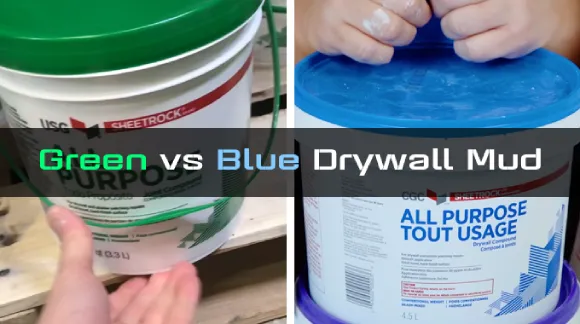Last Updated on March 5, 2023
If you’re tackling a construction project, it pays to know the ins and outs of green vs blue drywall mud. They may look similar but have distinct characteristics that could be game-changers for your success.
Differentiating factors like application, sand-ability, thickness/consistency, weight & stickiness all contribute to determining which type is right for you, so deciphering between them can give your next building venture an extra boost.
Green drywall mud is typically used as an undercoat for the first layer, while blue is often applied on final coat applications.
The green drywall mud is stronger but harder to sand. Also, green drywall mud is thicker and heavier than blue and dries in white, while blue dries in light blue.
Blue drywall mud has the advantage in terms of sand-ability and stickiness as it takes less sandpaper and has less sticky properties compared to the green variety.
We will dive into all the details surrounding green vs blue drywall mud to help you decide which one is best for your project.
Differences Between Green vs Blue Drywall Mud
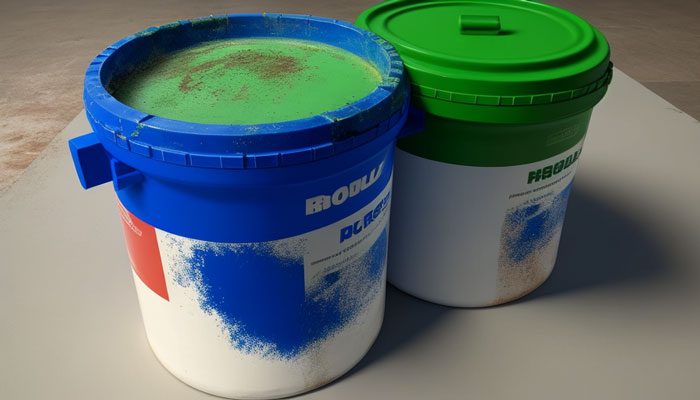
Applications
Green drywall mud is often applied under the first layer of regular drywall over drywall tape, providing great coverage and protection. This type of mud is perfect for joint taping and screw covering, helping ensure the wall surface remains even and smooth.
Blue drywall mud, also known as finish mud, is typically used on final coat applications. When blue drywall joint compound is applied over green drywall mud, it creates a smooth finish, giving walls a professional look.
Thickness/Consistency
Green drywall mud has a thicker and dense consistency compared to blue. This kind of thick consistency means it takes longer for green drywall mudding projects to set, but it provides superior coverage in comparison with blue, which tends to be softer with less coverage overall.
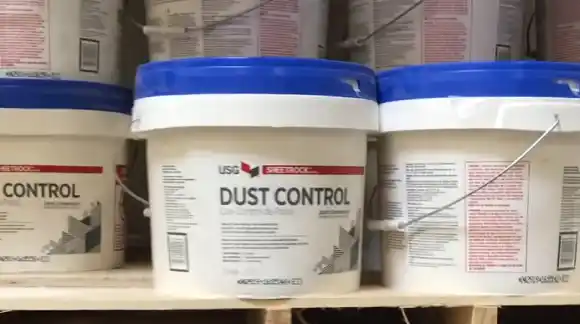
The thickness of green drywall mudding allows it to hold up well against bumps and scratches while still forming into corners easily without cracking or crumbling.
Blue drywall mudding has a creamy, soft consistency that makes it easier to apply across wide surfaces without leaving any gaps or visible inconsistencies in the finished product.
While this type of mudding may not offer as much protection against bumps as green does, its smooth texture makes it ideal for creating flawless finishes on walls with minimal effort required on the user’s part.
Strength/Durability
Green drywall mudding offers more strength than its blue counterpart so it holds up better against abuse in high-traffic areas. Such as hallways or stairwells where it’s constantly exposed to people bumping into the walls or rubbing up against them.
The green mud also has a higher tensile strength, so it won’t crack or crumble when someone leans against it frequently or if objects are placed right on it.
For these reasons, green is often considered a better option when considering durability and strength than blue mudding, which doesn’t have quite as high of a tensile strength rating as green does.
Blue drywall mudding is commonly seen indoors but is not particularly strong compared to its green counterpart because its softer setting compound makes it more easily damaged by incidental contact. Such as people bumping into walls or placing objects directly onto them nearby.
Although this type of mudding may last for years indoors if properly cared for, if you’re expecting heavy traffic in an area, green might be your better option if you’re looking for maximum durability and strength from your wall coating solution.
Sandability
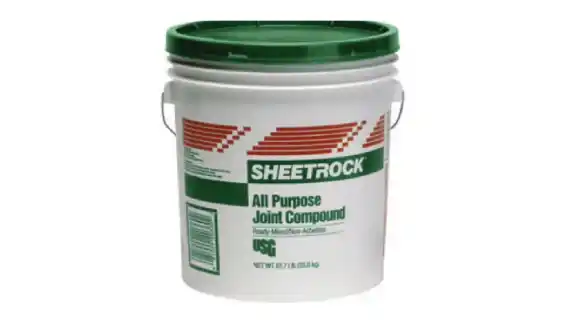
Green drywall muds are harder to sand down since they are thicker than their blue counterparts. Yet, they do provide durable coverage while still being able to form corners without cracking or crumbling away like other kinds of mortar do when sanded down heavily enough over multiple points around them (such as joints).
Sanding down green drywall compound requires specialized tools and techniques since they tend not to be very malleable, like thinner materials.
Due to their thinner composition, blue drywall muds take less sandpaper than their greener counterparts and are easier to sand down around various places (like edges).
Some homeowners may find that working around curves with this kind of material can prove difficult since these types don’t usually have strong adhesive properties making them prone to chipping away if not worked on carefully enough during the sanding process.
Anyhow, blue drywall muds require less work overall when it comes to sanding because of its soft nature. Because of this, they’re easier to work with around curves.
Weight
Green drywall mud is a much heavier weight than blue drywall mud. It’s usually about 25% heavier when compared to its counterpart.
This heavier weight makes it better fill large holes and cracks effectively and adds some strength during installation compared to its counterpart.
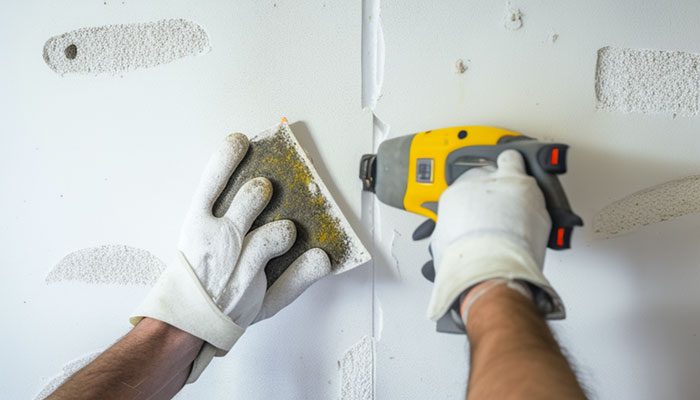
Blue lid drywall mud is a lightweight compound, allowing it to spread easily over the wall or ceiling surface, creating an even finish without any blemishes or bumps.
Flexibility
Blue lid drywall mud has greater flexibility when compared to green lid drywall mud. Its softer consistency allows you to work with it more easily when trying to achieve smooth, seamless finishes on walls or ceilings while still providing enough strength and stability during installation.
On the other hand, the green lid is not as flexible but provides better adhesiveness, which helps create a strong bond between surfaces that need patching or repairing with this type of product.
Paint Absorption
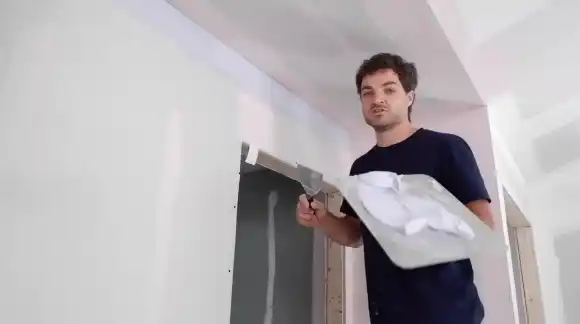
Because of its lighter weight and less dense consistency, the blue lid dries faster and absorbs paint deeper into the wall surface than the green lid does, allowing for better coverage but also leading to potential problems such as bubbling if too much paint is applied at once.
In contrast, the green lid’s thicker consistency prevents the paint from getting too deep into the wall. But, this can lead to less even coverage overall due to patches of paint not getting through properly due to its lack of flexibility relative to blue lid drier wall products.
Stickiness
Green lid drywall muds are much stickier than blue lid drywall muds due to their higher density and higher viscosity levels giving them stronger adhesion capabilities when bonding various materials together, such as plasterboard or wood paneling.
Blue lid drywall muds have lower viscosity levels meaning they are less sticky. This creates weaker bonds between materials but is more suitable for achieving smoother finishes in applications where precise detailing must be completed without leaving any residue around joints, etc.
Shrink Ability
When drying out, both types of lids will undergo some shrinkage, which isn’t uniform between both products.
The green lid will shrink more visibly due to its higher density content, while the blue lid may not show signs of shrinking, mainly if applied thin enough onto a given area before drying out completely.
Some minor shrinkage may still happen depending on how wet or moist the product was upon application versus how long it was left out before hardening off inside any given room-temperature environment.
VOCs/Toxicity
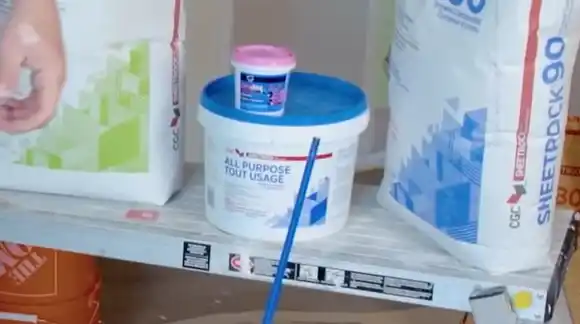
Green drywall mud is an environmentally friendly product with a low amount of Volatile Organic Compounds (VOCs), making it safe to handle and use in residential and commercial settings.
Also, it is non-toxic, biodegradable, and contains no hazardous materials. It has a minimal environmental impact because of its natural composition and lack of potentially noxious fumes.
In comparison, blue drywall mud is made from an alkaline concrete mix, making it non-toxic but slightly corrosive to some surfaces. Unlike green drywall mud, blue drywall mud contains no VOCs and has been approved for use in areas where indoor air quality must be monitored or maintained.
Flammability
Green drywall mud is extremely difficult to ignite and therefore offers added peace of mind when used in a potentially flammable atmosphere.
Its non-soluble nature means that any residual flame will extinguish quickly without causing damage to the surface below. On the other hand, blue drywall mud has been found to be more flammable than green drywall mud due to its higher alkalinity.
Color
Green drywall mud is bright white when freshly mixed and dries even whiter after application. Aside from that, this type of mud can be tinted by mixing lime and water. But no other chemical additives should be used as they could alter the properties of the material.
In comparison, blue drywall mud has a light blue tone that can be tinted to match primer paint colors with the addition of lime and water, but again this should be done sparingly as too much could compromise its performance characteristics.
Bubbles
Green drywall mud typically does not create bubbles during its application process because it has a thicker consistency than blue drying wall mud, which tends to form bubbles more easily if it’s not handled properly.
Blue drying wall mud also requires more frequent stirring before application to ensure there are no air pockets in the mixture which could cause bubbles to form when applied on walls or ceilings.
Green vs Blue Drywall Mud: Which One is Better?

From the information provided, it is clear that both green and blue drywall mud serve different purposes. The green drywall mud is a multi-purpose undercoat used for joint taping, screw covering, and other applications.
It is strong and resistant to damage but can be difficult to sand. On the other hand, the blue drywall mud is used mainly as a finishing coat and provides a softer set compound. Although it is not as strong or durable as green, it is much easier to sand than its counterpart.
Ultimately, both types of drywall mud have their own pros and cons. When considering which one is better, it depends on the situation.
Using both together can be beneficial in creating a more aesthetically pleasing gypsum board wall finish and greater durability overall. Applying the first layer of green followed by a second layer of blue after drying will create an optimal finish that will last for a while.
Can You Mix Green and Blue Mud Together?
Mixing green and blue mud isn’t recommended. This is because the chemicals used in each type of mud can interact with one another and cause a reaction that could ruin the surface being worked on or discolorate the results.
Even if mixing them had no chemical consequences, the color created would be unpredictable and potentially unattractive. You’ll just layer these two drywall muds on top of each other, green first and blue after it dries.
How Long Does Blue Drywall Mud Take to Dry?
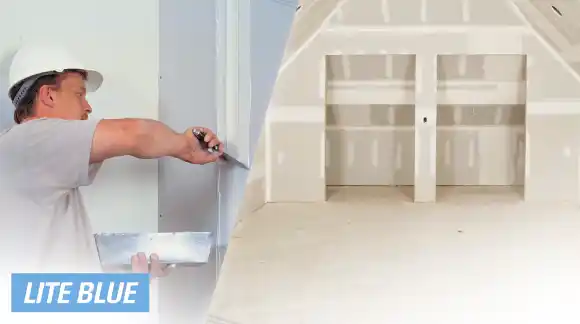
The drying time for blue drywall mud will depend on the temperature and humidity in the surrounding environment. When working in an area with a temperature of 70°F and 70% humidity, blue drywall mud will take approximately 24 hours to dry.
It should also be noted that the drying process may take longer if the temperature or humidity levels are too low or too high for optimal drying conditions.
Areas with poor ventilation will also likely experience slower drying times compared to those with good air circulation.
Proper preparation can help speed up this process by ensuring that any excess moisture from earlier layers has been adequately removed before applying new mud layers.
Know the Differences Between Green & Blue Drywall Mud and Achieve Professional Results
To sum it up, understanding the difference between green and blue drywall mud can make all the difference when it comes to achieving a professional finish on walls or ceilings.
While green drywall mud offers superior strength when used as an undercoat layer, blue drywall mud provides a better final coat because of its softer consistency and lighter weight.
Because of its stickiness, green drywall mud can be more difficult to sand down than its counterpart while still providing the exact color outcome upon drying. With these facts in mind, you can choose the right type of drywall mud according to your needs and achieve maximum results.
